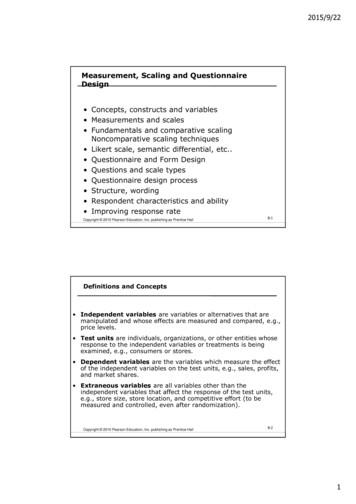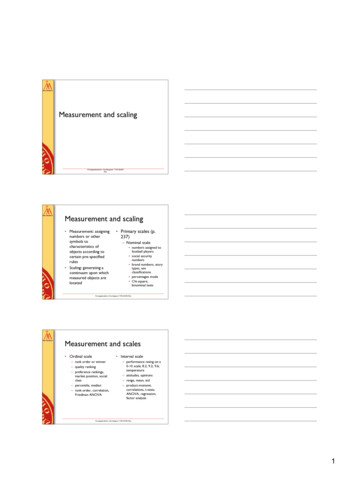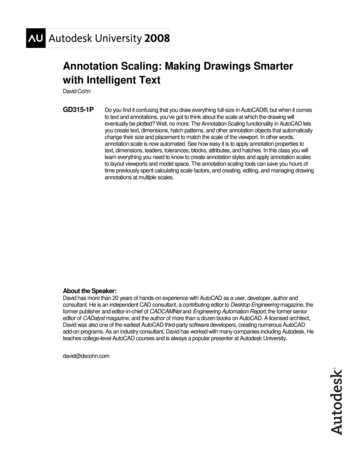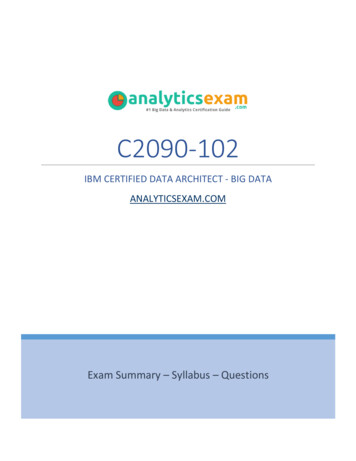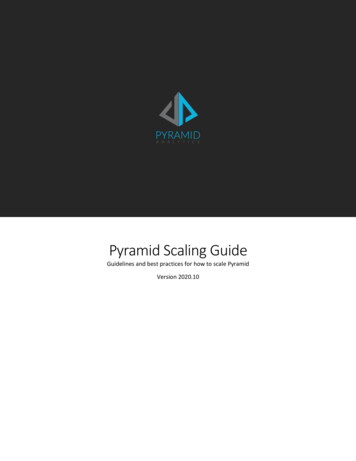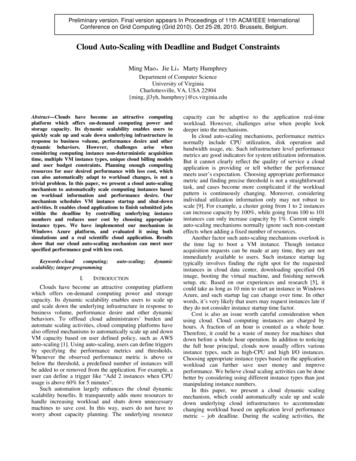
Transcription
Key Messagesfor 1000 Special Days
Table of ContentsChapter 1: Maternal Nutrition11.1 Pregnant Women11.2 Safe Delivery21.3 Lactating Women3Chapter 2: Infant and Young Child Feeding42.1 Exclusive Breastfeeding42.1.1 Breastfeeding Positions52.1.2 Good Attachment62.1.3 Feeding a Low Birth Weight Baby82.1.4. Expressing Breast Milk92.1.5 Feeding the Sick Baby Less Than 6 Months of Age122.2 Complementary Feeding132.2.1 Complementary Feeding When the Baby Reaches 6 Months132.2.2 Complementary Feeding from 6 Months up to 9 Months152.2.3 Complementary Feeding from 9 Months up to 12 Months172.2.4 Complementary Feeding from 12 Months up to 24 Months182.2.5 Feeding the Sick Baby 6 Months of Age and Older202.3 Infant Feeding in the Context of HIV22Chapter 3: Dietary Diversification23Chapter 4: Micronutrients264.1 Vitamin A264.2 Iodine274.3 Iron294.4 Folate (Vitamin B9)31Chapter 5: Growth Monitoring and Promotion5.1 When to Bring the Child to the Health Facility3233Key Messages For 1000 Special Days
1Chapter 1: Maternal NutritionIntroductionAdequate nutrition before and during pregnancyand throughout the lactation period is critical forproper growth and development of the child.1.1 Pregnant WomenKey MessagesPregnant women should eat two extra meals in between main meals each day foradditional energy and nutrients for themselves and their growing baby.Pregnant women who feel nausea should eat small and frequent meals, 5 or 6 times aday.Pregnant women must eat nutritious meals every day which include locally availablefoods from all the six food groups.Pregnant women MUST avoid alcohol and smoking.Pregnant women should take iron and folic acid tablets as directed by the health workerto prevent anaemia.Households should use iodized salt to ensure adequate intake of iodine.Pregnant women should visit the antenatal clinic at least four times for pregnancymonitoring, vaccinations, malaria prophylaxis, and to receive de-worming tablets.Pregnant women and children under 5 should sleep under long lasting insecticide-treatedmosquito net every night, all year round to prevent malaria.Pregnant women should get tested together with their partners to know their HIV statusand access support services. Key Messages For 1000 Special Days
21.2 Safe DeliveryIntroductionSafe delivery services are conducted by skilled health workers at a healthfacility to ensure the health of the mother and baby. Therefore, all mothersmust deliver at a health facility.Key MessagesPregnant women should be taken to the health facility at the onset of labour.Once the baby is born, the newborn should be put onto the chest of the mother skin-toskin immediately after birth, to keep the baby warm and to promote bonding.Initiate breastfeeding within the first 30 minutes of birth to ensure that the baby sucklescolostrum, (the thick yellowish foremilk), which is good for the baby because it providesimmunity to the baby. It also prevents postpartum bleeding.When breastfeeding, mothers should empty one breastbefore switching to the other to enhance milk production.Key Messages For 1000 Special Days
31.3 Lactating WomenKey MessagesLactating women should eat one extra meal each day for additional energy and nutrientsfor themselves and their growing baby.Lactating women must eat nutritious meals every day which include locally availablefoods from all the six food groups.Lactating women MUST avoid alcohol and smoking.Lactating mothers should take vitamin A capsule immediately after delivery or within 8weeks so that the baby receives the vitamin A in the breast milk.Households should use iodized salt to ensure adequate intake of iodine.Lactating women and children under 5 should sleep under long lasting insecticidetreated mosquito net every night, all year round to prevent malaria.Lactating women should get tested together with their partners to know their HIV statusand access support services. Key Messages For 1000 Special Days
4Chapter 2: Infant and Young Child Feeding2.1 Exclusive BreastfeedingIntroductionBreastfeeding is the natural and best wayof infant feeding because it saves livesand improves the quality of life of infantsand young children. During the first sixmonths, the baby should only be givenbreast milk; this is called exclusive breastfeeding. Exclusive breastfeeding for thefirst 6 months protects your baby from many illnesses, such as diarrhoeaand respiratory infections. For the mother breastfeeding reduces bleedingand chances of ovarian and breast cancers.Key MessagesMothers should exclusively breastfeed their baby from birth to 6 months (do not giveother foods and fluids including water).Mothers should breastfeed on demand, both day and night to ensure that the babyconsumes adequate milk and to enhance milk production. The mother should thereforenot be separated from her baby at night.Mothers should continue breastfeeding even when the baby is ill.While breastfeeding the baby mothers should not engage in any other chores but sitcomfortably and breastfeed. Ask others for help with household chores.Key Messages For 1000 Special Days
52.1.1 Breastfeeding Positionsb.a.c.d.d.IntroductionGood positioning ensures that the baby suckles well and that the motherproduces adequate supply of breast milk. The key positions are:a.Cradle position (most commonly used)b.Cross cradle position (good for small babies)c.Side-lying position (used when resting while breastfeeding and atnight)d.Under-arm position (used after caesarean section, if the mother’snipples are painful or if the mother is breastfeeding twins or a smallbaby)Key messagesWhen breastfeeding the baby, the mother should ensure that;The baby’s body should be straight, not bent or twisted, but with the head slightlyback.The baby’s body should be facing the breast not held flat to the mother’s chest orabdomen, and the baby should be able to look up into the mother’s face.The baby should be close to the mother.The baby’s whole body is supported, not just the neck and shoulders, with a hand andforearm. Key Messages For 1000 Special Days
62.1.2 Good AttachmentIntroductionGood attachment ensures that the baby suckles well and the motherproduces adequate supply of breast milk. It also prevents sore and crackednipples. If the mother experiences pain when breastfeeding, she shouldseek help at the health facility.Effective suckling helps the mother to produce milk and satisfy the baby.After the baby empties one breast offer the other breast to ensure that milkproduction is stimulated in both breasts. The signs of effective sucklingare:a.The baby takes slow deep suckles, sometimes pausing.b.The mother should be able to see or hear the baby swallowing afterone or two suckles.c.Suckling is comfortable and pain free for the mother.d.The baby finishes the feed, releases the breast and looks contentand relaxed.e.The breast is softer after the feed.Key Messages For 1000 Special Days
7Key messagesFor good attachment the mother should ensure that;The baby’s mouth is wide openThe darker skin (areola) should be seen more above the baby’s mouth than belowBaby’s lower lip is turned outwardsBaby’s chin is touching the mother’s breast Key Messages For 1000 Special Days
82.1.3 Feeding a Low Birth Weight BabyIntroductionA low birth weight baby refers to a baby that is born weighing less than2.5kgs at full term. Breast milk is especially adapted to the nutritionalneeds of low birth weight babies. The best milk for a low birth weight babyis the breast milk from the baby’s own mother.Key MessagesMothers should breastfeed frequently to get the baby used to the breast and to keepthe milk flowing. Long slow feeds are fine.Mothers should breastfeed the baby frequently even when he or she is not crying.Mothers should use the cross cradle and underarm positions for feeding a low birthweight baby.Mothers should tap/tickle the baby’s feet to help waken him or her for the feed if thebaby sleeps for long periods of time.Mothers should use Kangaroo mother care to provide skin-to-skin contact, warmthand closeness to the breast, encourage early initiation of breast feeding and exclusivebreastfeeding, either by direct feeding or using expressed breast milk given by cup.Different caregivers should also share in the care of the baby using the same Kangaroomethod position.Mothers and caregivers should identify the following signs of hunger: Being alert and restless, Opening mouth and turning head to the direction of the breast. Putting tongue in and out, sucking on hand or fist looking for the direction ofthe breastKey Messages For 1000 Special Days
92.1.4 Expressing Breast MilkIntroductionDirect breastfeeding of premature or very small babies may not be possiblefor several weeks. Mothers should therefore be taught and encouraged toexpress breast milk and feed the baby using a clean cup. Key Messages For 1000 Special Days
10Key MessagesMothers and caregivers should: Wash hands and utensils using soap and clean running water. Clean and boil the container to be used to collect the breast milk. Gently stroke the breasts or use a warm cloth to help stimulate the flow of milk.Mothers should place the thumb on the breast above the dark area (areola) around thenipple and the other fingers on the underside of the breast behind the areola.Mothers should use the thumb and first 2 fingers press a little bit in towards chest walland then press gently towards the areola.Mothers should collect the milk in the clean container. Milk may start to flow in drops, orsometimes in fine streams.Mothers should avoid rubbing the skin, which can cause bruising, or squeezing the nipple,which stops the flow of milk.Mothers should rotate the thumb and finger positions and press gently and release allaround the areolaMothers should express one breast for at least 3 to 5 minutes until the flow slows, thenexpress the other breast and then repeat both sides (20 to 30 minutes total).Mothers should store breast milk in a clean, covered container. Milk can be stored 6 to 8hours in a cool place such as a clay pot and up to 72 hours in the refrigerator.Mothers should pour just enough breast milk from the clean covered container into thefeeding cup.Mothers should give baby expressed breast milk from a clean cup. Bring the cup to thebaby’s lower lip and allow the baby to take small sips of milk. Do not pour the milk intobaby’s mouth.Mothers should not use bottles because they easily get contaminated and are difficult towash.Key Messages For 1000 Special Days
11When the mother is going away from home, she should: Take the baby with her if possible. If this is not possible, consider having someonebring the baby for breastfeeding. Take time to feed the baby before leaving home and resume breastfeedingupon return. Express and store breast milk in a clean cup or container before leaving the homeso that the baby’s caregiver can feed the baby. Expressed breast milk (stored in acool, covered place) stays in good condition for 8 hours, even in a hot climate. Continue expressing breast milk while away from the baby to keep the milkflowing and prevent breast swelling. Teach the baby’s caregiver how to use a clean open cup to feed the baby. Get support in caring for the baby and other children, and for doing householdchores from family members. Key Messages For 1000 Special Days
122.1.5 Feeding the Sick Baby Less Than 6 Months of AgeIntroductionDuring illness children are more likely to have problems with feeding dueto loss of appetite and vomiting. Special care is needed therefore whenfeeding them.Key messages:Mothers should breastfeed more frequently when the baby is ill, even when he/she hasdiarrhoea, to prevent weight loss and speed up recovery.Mothers and caregivers should immediately take the sick baby to the health facility if thebaby is refusing to breastfeed.Mothers should continue exclusive breastfeeding when the baby is sick.Mothers and caregivers should only give medicines that have been prescribed by thehealth care provider.Mothers should give expressed breast milk if the baby is too weak to suckle.Mothers should increase the frequency of breastfeeding during the recovery period tohelp the baby regain weight and catch up in growth.Key Messages For 1000 Special Days
132.2 Complementary Feeding2.2.1 Complementary Feeding When the Baby Reaches6 MonthsIntroductionFrom 6 months onwards, breast milk alone is not enough to meet thenutritional requirements of the rapidly growing baby, as such the babyneeds other foods in addition to breast milk. Therefore, there is need tointroduce other complementary foods.Examples of complementary foods from the six food groups are: staplefoods like porridge (maize, rice, millet, potatoes, sorghum), mashed bananaor mashed potato which will give your child energy; legumes like beans,peas; meat and meat products like soft meat, fish, eggs which help yourchild to be strong; Fruits like mangoes, tangerines, oranges, avocado, juiceof baobab which will protect your child from illness; vegetables like greenleafy vegetables like nkhwani, khwanya, chisoso. Key Messages For 1000 Special Days
14Key MessagesMothers should continue breastfeeding the baby on demand at least 8 times both dayand night to meet the nutritional needs of the baby and maintain his/her health andstrength.Mothers should continue to breastfeed the baby until 2 years of age or older.Mothers should breastfeed first before giving other foods.Mothers and caregivers should feed the baby complementary foods at least 2 time a day.Mothers and caregivers should give 2 to 3 tablespoonfuls at each feed and the food shouldbe thick enough to be fed by hand.Mothers and caregivers should avoid giving thin watery porridge as it will fill the stomachbut not provide nutrients.Mothers and caregivers should not give fizzy drinks as it does not help the baby to grow.Mothers and caregivers should be patient and actively encourage the baby to eat andavoid force feeding because the baby may need time to get used to eating foods inaddition to breast milk.Mothers and caregivers should use a separate plate to feed the baby to make sure he orshe eats all of the food given.Mothers and caregivers should store food in a covered clean container and give it to thebaby within two hours of cooking.Mothers and caregivers should use a clean cup to give foods or liquids to the baby. Donot use bottles, teats or spouted cups to feed the baby. They are difficult to clean and canmake the baby sick.Mothers and caregivers should wash hands and the baby’s hands with soap and cleanrunning water before preparing food, feeding the baby, after using the toilet and cleaningthe baby’s bottom.Key Messages For 1000 Special Days
15Mothers and caregivers should treat drinking water by boiling or using Water Guard andkeep all drinking water in clean covered containers.2.2.2 Complementary Feeding from 6 Months up to 9MonthsIntroductionFrom 6 to 9 months, continue feeding the baby soft, mashed foods at least2 times per day. Food should be thick, not watery. The watery broth doesnot help your baby grow and would not satisfy his/her hunger.Key MessagesMothers and caregivers should:Give the baby thick porridge enriched with different foods like: groundnut flour or mashedor pounded vegetables like nkhwani, mpiru, or kholowa or dried vegetable powder; meatproducts like mazira, mkaka or nsomba yosinjasinja; fruits like mashed banana or freshfruit juice.Gradually increase the amount of food given to the baby so that by 9 months the baby isconsuming ¾ to 1 full standard cup (250 ml) 2-3 times per day.Give the baby a portion of fish, meat (chicken, mouse, goat, beef, pork, bird, rabbit), oredible insects once a day (at least two heaping tablespoons). These foods are a goodsource of iron. Pound or mince the meat or fish (be careful to remove bones from fish ifnecessary). Fry/roast small dried fish and grind with maize. Make thick porridge with thecombined flour. Prepare fresh fish with vegetables such as tomato. Mash very well for baby. Pound the baby’s portion of meat and then cook it. Key Messages For 1000 Special Days
16Serve the liver to the baby whenever preparing a chicken.Feed the baby a piece of fruit one to two times a day as it will improve his/her appetiteand growth.Prepare the family vegetables with some fat, oil or ground nut powder. Give a portion ofthe same vegetables to the baby.Do not give non-nutritious liquids or food to the baby like artificial juices (squashes),freezes, fizzy drinks, jiggies, puffs, sweet and biscuits as they are expensive and do not helpthe baby to grow. Instead it is cheaper to buy eggs or some fruits like banana, orange.Be patient and actively encourage the baby to eat. Don’t force feed.Use a separate plate to feed the baby to make sure he or she eats all the food given.Always use iodized salt.Add one new food to the child’s diet each week.Key Messages For 1000 Special Days
172.2.3 Complementary Feeding from 9 Months up to 12MonthsIntroductionAt this stage, the baby is growing fast sohe/she requires more food frequently butin small quantities to meet their growthand development needs. So the babyneeds to start the day with a meal in themorning.Continue to breastfeed the baby andincrease the amount of food given untilyou feed him/her a standard cup (250 ml)or eight tablespoons per meal. Feed yourbaby at least three times per day.Key MessagesMothers and caregivers should:Feed thick phala (porridge) made from the 6 food groups. These should include fortifiedfoods such as Likuni Phala, ufa wa mgaiwa and ground nut or soya flour or futali in themorning.Give soft nsima with mashed beans or any other relish (according to what the mother has)to start baby on the family meals.Bring some food to feed the baby and include snacks like fruits or some chikonda moyomade from enriched flour when they take the baby away from home.Wash their hands and the baby’s hands with soap and clean running water before feedinghim/her. Key Messages For 1000 Special Days
18Stay with the baby during meals. He/she will eat better when someone is there toencourage.Feed the baby before other family members until he/she has eaten enough.2.2.4 Complementary Feeding from 12 Months up to 24MonthsIntroductionDuring the period of 12 – 24 months children experience rapid growthas they go through various milestones such as tripling birth weight by 12months, walking, running all of which increases nutrient requirement. Inaddition the child is prone to various infections as they interact with theirsurrounding/environment further increasing their nutrient requirement.Continued breastfeeding with increased complementary feeding isrequired.Key Messages For 1000 Special Days
19Key messagesMothers should continue breastfeeding the baby on demand at least 8 times both dayand night to meet the nutritional needs of the baby and maintain his/her health andstrength.Mothers should breastfeed first before giving other foods.Mothers and caregivers should; Feed the child the same foods they feed the rest of the family and ensure that thefood is chopped and moistened. Feed the child at least 5 times per day, 3 main meals and nutritious snacks betweenmeals such as vegetables/fruits, sources of vitamin A, and foods prepared withfat – dark green vegetables – chisoso, nkhwani, moringa, bonongwe, kholowa,tomato, eggplant, carrot, cabbage, Fruits like orange, passion fruit, mango, papaya,banana, watermelon, pineapple, avocado, chikondamoyo, chitumbuwa. Increase portions of meat/fish/eggs Increase the amount of food given to the child so that by 24 months the child isfed 16 tablespoons.To achieve active/responsive feeding, mothers and caregivers should: Be patient and actively encourage the child to eat. Not force the child to eat. Use a separate plate to feed the child and make sure the child eats all the foodgiven.Good hygiene (cleanliness) is important to avoid diarrhoea and other illnesses. (CC 11) Toavoid diarrhea and other illnesses the caregiver should; Use a clean spoon or cup to give foods or liquids to the child. Store the foods to be given to the child in a safe hygienic place. Wash hands with soap and clean running water before preparing foods andfeeding the child. Wash the child’s hands with soap and clean running water before eating. Wash hands with soap and clean running water after using the toilet and washingor cleaning the child’s bottom. Key Messages For 1000 Special Days
202.2.5 Feeding the Sick Baby 6 Months of Age and OlderIntroductionChildren need more food and liquids when they are sick. Even if the child’sappetite is decreased, encourage him or her to eat small meals frequently.After the child has recovered, actively encourage him or her to eat oneadditional meal of solid food each day during the following few weeks.This will help the child regain the weight he or she has lost.Key Messages For 1000 Special Days
21Key MessagesMothers should breastfeed the sick child more frequently, to speed up recovery andreduce weight loss.Mothers and caregivers should provide ORS on the way to the health facility to a childwho has diarrhoea or is vomiting to replace lost salts and fluids in his/her body.Mothers and caregivers should feed the child simple foods like porridge and avoid spicyor fatty foods. Even if the child has diarrhoea, it is better for him or her to keep eating.When the mother is sick, she should continue to breastfeed the baby whenever possible.She may need extra food, liquids and support during this time.Mothers and caregivers should not use bottles, teats, or spouted cups as they are difficultto clean and can cause infection.Mothers and caregivers should offer other nutritious liquids in addition to breast milk; forexample, homemade fruit juice (orange, tangerine, malambe, guava, bwemba)Mothers and caregivers should offer small amounts of diverse nutritious foods morefrequently as the child needs extra food to gain weight and recover.Mothers and caregivers should offer the child his/her favorite nutritious foods.Mothers and caregivers should add a few drops of lemon to the child’s foods to providevitamin C and to improve the taste.Mothers and caregivers should offer fruits such as mango, papaya, and orange to stimulatethe sick child’s appetite. Key Messages For 1000 Special Days
222.3 Infant Feeding in the Context of HIVIntroductionAll pregnant women should go to antenatal clinics within the first trimesterto receive antenatal care including HIV testing and counselling. Pregnantwomen who are found HIV positive will be helped to reduce chances ofpassing on the virus to their unborn child. They receive care to keep theirbabies protected from HIV during pregnancy, labour and breastfeeding.Out of 100 babies born to women with HIV about 40 will get infected if noactions are taken, but with ART, less than 4 will get infected.Even in the context of HIV and AIDS, breastfeeding is the natural and bestway of infant feeding because it saves and improves the quality of life. Foran HIV positive lactating mother, exclusive breastfeeding reduces the riskof passing on HIV from mother to child. It also reduces the risk of otherchildhood illnesses like diarrhoea and pneumonia.Key MessagesPregnant women must be tested at a health facility to know their HIV status within thefirst trimester to receive optimal care.All lactating mothers should exclusively breastfeed for the first 6 months regardless oftheir HIV status. Giving other foods or drinks, including water, increases the risk of yourbaby becoming infected with HIV.If infants and young children are known to be already HIV infected, mothers are stronglyencouraged to continue breastfeeding up to two years of age and beyond.Families and communities should provide support to mothers so that they can rest, eatwell, practice good hygiene and care for the baby.All mothers should eat a variety of foods from the six food groups and eat two extra mealsevery day.Key Messages For 1000 Special Days
23Chapter 3: Dietary DiversificationIntroductionThe body needs different nutrients to function well and different foodsprovide different nutrients. Eating the right kinds and amounts of foodkeeps us healthy. No one food supplies all the nutrients the body needs andno one nutrient is most important. Each food group is essential because ofthe nutrients that it provides and each nutrient depends on other nutrientsfor it to carry out its proper function.Combining foods from different groups is not new in the Malawian culture.One-pot meals can combine meat, bananas and vegetables or cassavacooked together with pigeon peas and meat. A diverse diet does notnecessarily mean spending a lot of money.A diet that is not diversified will result in inadequate intake of nutrientswhich may cause under nutrition in pregnant women, lactating mothersand children under two years of age. Continuous under nutrition duringpregnancy and the first two years of life leads to chronic malnutrition alsoknown as stunting. The first 1000 days of life is critical for child growth anddevelopment. Key Messages For 1000 Special Days
24Key messagesTo ensure a diverse food supply households must: Have a backyard/kitchen garden and plant indigenous vegetables such asmnkhwani, chigwada, bonongwe, kholowa, etc. Grow oil seeds, such as groundnut, sesame, sunflower, pumpkin and soybeansto improve family meals. Plant at least two fruit trees such as mangoes, pawpaws, guavas, or oranges;choose several seasonal types to ensure that there is fruit available all yearround. Rear at least one or two types of small animals such as poultry, goats, sheep,rabbits, and guinea pigs to improve family meals. Preserve/dry fresh foods such as mangoes, masawu, tomatoes, okra, denje, etc.for use in time of scarcity. Drying is the most cost effective way of preservingfood at household level. Use a solar dryer if possible to retain nutrients andpreserve colour.To consume diverse foods households must; Include foods from all the six food groups in your diet every day. Plan meals using locally available vegetables like kholowa, mnkhwani, chisoso;animal foods like mazila, nkukhu, mbuzi, ngumbi, mbewa, mbalame, bwannoni,mphalabungu, and usipa, staples like chinangwa, mapila, mbatatesi andmbatata; fruits like masawu, mapapaya, mapeyala; and legumes like mtedza,nzama, khobwe, nandolo. Ensure pregnant women eat a diverse diet: no foods are forbidden duringpregnancy. Prepare diverse meals for the baby by mixing other foods into the porridge likegroundnut flour and mashed vegetables (pumpkin, mustard, or sweet potatoleaves; pumpkin, sweet potato, tomato, potato). Feed the children foods from all the six food groups every day through mealsand snacks.Key Messages For 1000 Special Days
25Households must prepare and handle food hygienically by: Washing hands with soap and water before preparing food and feeding baby. Washing hands and baby’s hands with soap and water before eating. Washing hands with soap and water after using the toilet and washing orcleaning baby’s bottom. Feeding the baby using clean hands and clean utensils. Using a clean spoon or cup to give foods or liquids to the baby. Do not usebottles, teats or spouted cups since they are easily contaminated and can causediarrhoea. Storing food in a safe clean place to be given to the baby. Treating drinking water so that it is safe by boiling or using chlorine orWaterGuard. Keeping treated water covered and using alternate cups (one for drawing waterand another for drinking.) Key Messages For 1000 Special Days
26Chapter 4: Micronutrients4.1 Vitamin AIntroductionVitamin A is a fat-soluble vitamin critical for growth anddevelopment, good eye sight, and immunity. Vitamin Ais also important during pregnancy for foetal development.Deficiency of Vitamin A in pregnancy may lead to poor development of thebaby and birth defects. In children, deficiency of vitamin A may also lead tostunting and increased duration and severity of childhood illnesses suchas measles, diarrhoea, pneumonia, and common cold. Other deficiencydisorders of vitamin A include night blindness,drying and damage of eyes, andincreased incidence of illness and death.Key messagesPregnant women, lactating mothers, and children should eat foods rich in Vitamin A everyday such as yellow/orange fruits and vegetables like ripe mangoes, pawpaws, pumpkin,and carrots; dark green leafy vegetables like bonongwe, chisoso, or kholowa preparedwith nsinjiro or cooking oil; eggs, milk and milk products.Children from 6 months should get a Vitamin A supplement (as recommended) every 6months from a health worker.Mothers who have just given birth should take a Vitamin A supplement within 8 weeks ofdelivery.Buy and consume centrally processed fortified foods such as cooking oil, sugar, maize andwheat flour, and Likuni Phala. Fortified foods can be identified by the fortification logo forMalawi. (as seen above)Key Messages For 1000 Special Days
274.2 IodineIntroductionIodine is a mineral essential for the control of metabolic processes and itregulates mental and physical development of an individual. It is importantthat pregnant women consume foods rich in iodine for foetal growth anddevelopment. Children need to consume iodine rich foods for propermental and physical growth and development.Severe iodine deficiency may result in dwarfism (short stature). This mayaffect the child’s performance in school, sports and other activities. Iodinedeficiency also leads to development of goitre and reduces productivityof an individual. In pregnancy, iodine deficiency may result in cretinism(severe mental retardation), miscarriages, stillbirths, or death of newbornchild.Woman with goitreCaretakers stimulating a mentally retarded boyMany soils in Malawi are low in iodine and most of the foods grown donot have adequate iodine. The most reliable source of iodine is thereforeiodized sal
a. Cradle position (most commonly used) b. Cross cradle position (good for small babies) c. Side-lying position (used when resting while breastfeeding and at night) d. Under-arm position (used after caesarean section, if the mother's nipples are painful or if the mother is breastfeeding twins or a small baby) Key messages

